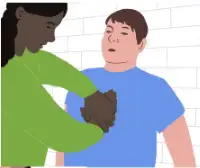Training and Assessment Delivered on Behalf of Allens Training Pty Ltd RTO 90909
Choking? Don’t make this common TV mistake

This, we’ve all see this. On just about every tv show, when someone’s choking you see the person performing first aid grab them around the belly and lift up. It’s called the “heimlich maneuver”
Did you know that what you see on every show is not in Australian first aid guidelines? Why not? This maneuver when done wrong, can actually severely injure someone.
There have been more than 50 studies that show that the Heimlich can damage internal organs and arteries. So what should you actually do? We are going to help you in this article
So let’s get started. We will go through two different types of chokes and look at what you should actually do. There will also be a great wall chart you can download and print for home or the workplace.
What to actually do?
Partial Choking
So first up, we need to talk about the first type of choke, a partial choke.
What is a partial choke? It’s when a person is choking, but their airways are not fully obstructed.
You’d likely notice them coughing and spluttering, and they’ll be highly anxious.
So what do you do at this point? Before you get too excited, guidelines say to simply give the person reassurance, and encourage them to cough. We could also help them get into a comfortable position.

Why not do something more at this point? Because acting too early could make things worse and cause the obstruction to move further down instead of out.
At this point, either of two things could happen. The person will cough out the obstruction, or things will get worse and they’ll no longer be able to cough. Make sure to call an ambulance.
What do we do next?
Full Choking

If the person is unable to cough, this is what we call a full choke. You will notice that there is no escape of air or coughing or gasping at this point. The person will be extremely agitated/anxious and likely have their hands to their throat.
Now is our time to act. There’s a procedure we can follow to help that’s different from the Heimlich on tv. Our first step is to give five back blows. How do you give them? Using the heel of your hand strike the person in the middle of the back between the shoulder blades.
When giving the back blows, your aim is to clear the airways on each hit. So hit fairly hard.

If the back blows don’t work, what’s next? You should perform 5 chest thrusts.
How do you give a chest thrust? You need to push hard in the centre of the persons chest. You’ll put your hands in the same spot where you would to give CPR. Have the person stand against a wall and push hard up to 5 times to try to clear the obstruction.
This technique is far safer than the Heimlich to perform and often leads to a great result.
CPR or not?
So by this point, you’ll likely have cleared the obstruction. Great! But in the chance you haven’t, what would come next?
A person who has been fully choking will eventually become unconscious. If the obstruction is visible and able to be pulled out of their mouth, try to. But if it isn’t. is there anything you can do to help until emergency services arrive? Many people wonder, if they can’t breathe, should you bother with CPR?
The surprising answer is YES! if someone is unconscious and choking definitely give them cpr. The breaths won’t work, but what will work is chest compressions!
When you give someone chest compressions, it helps circulate oxygen through their organs (especially the brain) to keep them alive for medical professionals to revive.

Although they can’t get fresh oxygen, doing chest compressions will help circulate the remaining oxygen in their lungs to prolong life, and it may assist in expelling the obstruction
So for sure, give CPR! You can read some helpful tips about it in our Ultimate Guide to DRSABCD
Conclusion
So what you’ve seen on TV, don’t try in real life. Rather than an outdated maneuver that injures people, we’ve learnt to encourage coughing, and then if a person can no longer cough give 5 back blows, 5 chest thrusts and then CPR.
Knowing what to do, and acting with confidence goes along way to saving someone’s life. We’ve got this handy wall chart for you to download. Why not print these basics of choking out and keep them somewhere visible! (perhaps your staff lunch room)
And if you’d like to learn more about these guidelines. Book into one of our practical and engaging first aid courses today!


